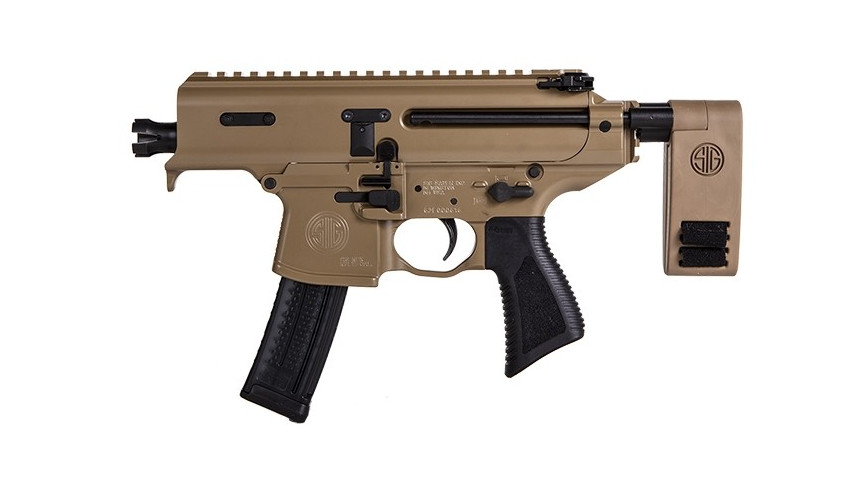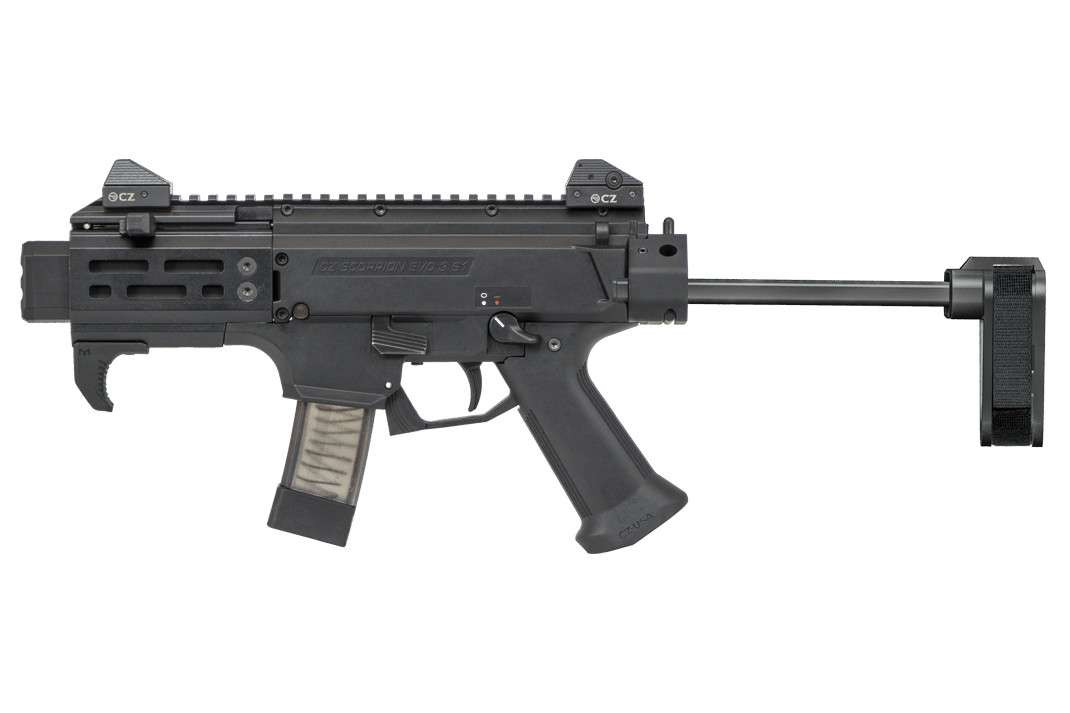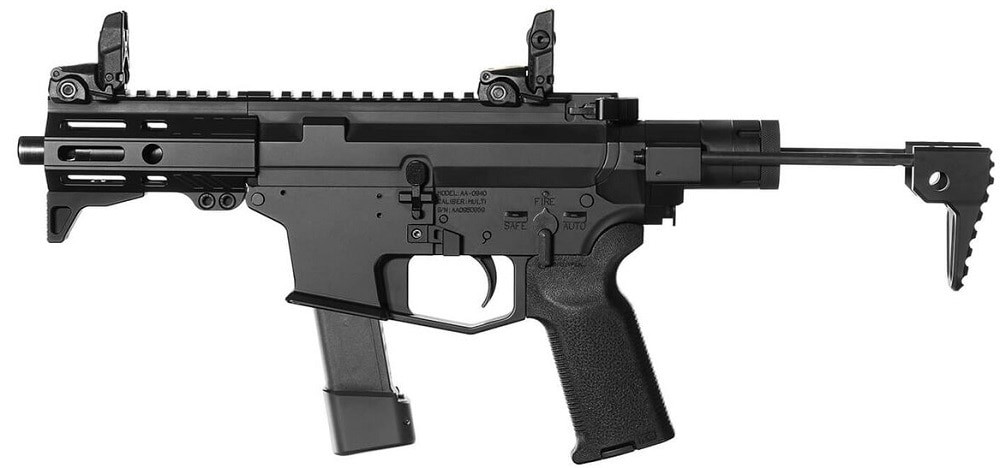Reporters and members of the public are getting a chance to get their hands on Sig Sauer’s new ultra-compact MPX Copperhead at the annual SHOT Show firearms trade show in Las Vegas. The company is pitching the gun hard toward the U.S. civilian market as a 9mm “pistol,” but its select-fire version should attract interest from military and law enforcement units. It looks particularly well suited as an option for the U.S. Army’s requirements for a new, super small submachine gun.
The American subsidiary of Sig Sauer, which has its main headquarters in Germany, first announced the Copperhead on Jan. 7, 2019, but the gun had been in development for months before that. It draws inspiration and includes numerous features from the Rattler, the sub-compact member of the increasingly popular MCX rifle family. U.S. Special Operations Command (SOCOM) is evaluating that weapon already, which you can read about in more depth here.
“The MPX Copperhead considerably reduces the length, width, and size of the MPX platform making it the most compact addition to the MPX family of firearms,” Tom Taylor, Chief Marketing Officer and Executive Vice President of Commercial Sales at SIG SAUER, Inc, told Shooting Illustrated in an interview earlier in January 2019. “The Copperhead is the perfect combination of the features and performance our consumers expect from a SIG MPX in a compact package.”
Sig Sauer first introduced the MPX 9mm submachine gun in 2015 and now offers those guns with a variety of barrel lengths and the option for an integral sound suppressor. Additional, semi-automatic-only variants that are legal on the U.S. civilian market soon followed.

The guns are externally reminiscent of the AR-15/M16 family of rifles and they also incorporate design features from the MCX series, which are derived, in part, from those earlier guns. But the MPX is an entirely separate weapon.
The standard submachine gun type has an eight-inch barrel and overall length of fewer than 17 inches with its stock collapsed. An existing compact variant, the MPX K, cut that down further with only a four-and-a-half-inch barrel.

Copperhead has a three-and-a-half-inch barrel and an overall length of just 14.5-inches. It’s also narrower than the standard MPX and has a shortened pistol grip, making it easier to conceal in a bag or under a coat. It weighs a mere four-and-half pounds, two pounds lighter than the full-size submachine gun version.
The gun is so short it has a monolithic upper receiver and no separate handguard. The civilian pistol version keeps size further to a minimum by having a barrel with a flash hider machined right into the end. The military and law enforcement focused version has a more traditional threaded muzzle that allows the user to install different kinds of devices, including quick-detach systems for a sound suppressor.

An accessory rail on the top means the gun can accept various optics. With a gun this tiny, a non-magnifying, compact red dot or holographic sight for rapid aiming would probably make the most sense.
The submachine gun version comes with an extremely low-profile personal defense weapon (PDW) style collapsible stock, while the civilian version has a collapsing arm brace, instead, to meet the U.S. legal definition of a pistol. Both types had a small accessory rail on the back to accept any of the side-folding stocks that Sig Sauer offers for the MPX and MCX families.
As already noted, the MCX is seeing increasing sales, including to military and law enforcement elements. The MPX has secured a number of sales, as well. So the addition of the ultra-compact type could easily help increase that market share, especially to units focused on VIP protection and other close-quarters operations, where a small, portable, and highly concealable weapon with a higher rate of fire and far more accuracy than a handgun could be highly advantageous.

These are notably among the core demands the U.S. Army has laid out for its Sub Compact Weapon (SCW) program. The service is looking to acquire as many as 1,000 guns for personal security details guarding senior officers and other “high risk personnel” in dangerous areas.
The Army wants a gun that is 15 inches long or less with the stock in the collapsed position, has a barrel no longer than five-and-a-half inches, and weighs under seven pounds. The Copperhead meets all of these requirements with a lot of room to spare, as well as the service’s demands for certain features, including a collapsible stock rather than a folding one. You can find the full details about the SCW program’s publicly known requirements here.
The MPX had already seemed like a leading contender given the gun’s existing features and the U.S. military’s growing interest in the weapon, as well as the MCX rifle series. In July 2018, the Army hired Sig Sauer to provide a variety of weapons, including MPX and MCX types, as part of a large order for American special operators, other unnamed U.S. government agencies, and unspecified foreign allies.
Copperhead, or a further version thereof, was almost certainly Sig Sauer’s final submission the SCW program, which should already in the process of evaluating the various entrants. That’s not to say it won’t still face competition from some of the other entrants. The Czech EVO 3 Micro is heavier and has a longer barrel and overall lengths, but still meets the Army’s requirements.

The SCW-9, a late entry from North Carolina-based Angstadt Arms, is almost as short as the Copperhead and actually weighs less. Perhaps more importantly, it uses the same magazines as Glock 17/19 pistols, which have developed a major following within the U.S. military, especially within the special operations community.

Of course, the SCWs are destined for regular Army units, so this might not matter as much. The service recently adopted Sig Sauer’s M17 and M18 as its standard service pistols.
The Army’s timeline for the program envisioned at least down-selecting from the multiple submissions soon and that the final guns could be in the hands of personal security details as early as this year. So it may not be long before we know whether troops guarding VIPs will be carrying Copperheads or not. Regardless, we’ll be keeping an eye out for where else these tiny sub guns end up.
Contact the author: jtrevithickpr@gmail.com
